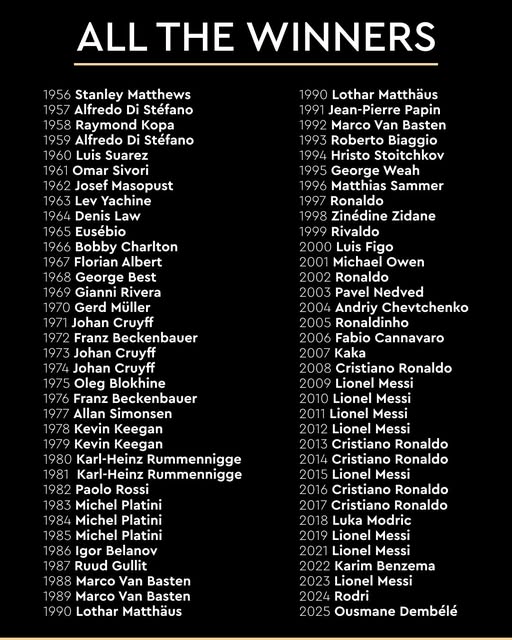Ballon d’Or 2025: A Night of Triumph, Records, and Legacy
Date & Venue:
The 69th Ballon d’Or ceremony took place on 22 September 2025, at the Théâtre du Châtelet in Paris, France.
Organizers & Hosts:
Presented by France Football, in partnership with UEFA and other media partners. The ceremony was hosted by Kate Scott and Ruud Gullit.
What’s New This Year
2025 saw the Ballon d’Or further expand its reach and inclusivity:
- The awards are now fully based on the 2024-25 season rather than calendar year—a change already adopted but reaffirmed.
- There are new awards in women’s football, namely the Women’s Yashin Trophy, Women’s Gerd Müller Trophy, and Women’s Kopa Trophy. This reflects growing parity and recognition for female players.
- Club of the Year awards for both men’s and women’s teams continue to play a prominent part in the ceremony.
Winners & Highlights
Ousmane Dembélé Wins 2025 Ballon d’Or: PSG Star Crowned the World’s Best Player
In a historic night at the Théâtre du Châtelet, Ousmane Dembélé was crowned the 2025 Ballon d’Or winner, cementing his place among football’s elite. The Paris Saint-Germain forward became the sixth Frenchman in history to win the award, and the first to do so while playing in Ligue 1 since Jean-Pierre Papin in 1991.
Aitana Bonmatí Wins 2025 Women’s Ballon d’Or: The Spanish Maestro Secures Historic Third Consecutive Award
Barcelona and Spain star Aitana Bonmatí has been crowned the 2025 Women’s Ballon d’Or winner, making history as the first female player to win the award three years in a row. The elegant midfielder continues to dominate the global stage, blending creativity, vision, and leadership in a way that has redefined modern women’s football.
Here are the leading honours and standout moments:
| Award | Winner | Key Facts / Significance |
|---|---|---|
| Men’s Ballon d’Or | Ousmane Dembélé (Paris Saint-Germain) | First-time winner; became the 6th Frenchman to win while playing in France; pivotal in PSG’s first Champions League triumph. |
| Women’s Ballon d’Or | Aitana Bonmatí (FC Barcelona) | Won for a third consecutive year, cementing her status among the elite players in women’s football. |
| Men’s Kopa Trophy (best young male player) | Lamine Yamal | Defended his title; continues to impress for club & country. |
| Women’s Kopa Trophy | Vicky López | Her first such prize; signals emerging female talent. |
| Men’s Yashin Trophy (best male goalkeeper) | Gianluigi Donnarumma | Important recognition for PSG’s defensive strength. |
| Women’s Yashin Trophy | Hannah Hampton | The first ever recipient of the women’s version; milestone for goalkeepers in women’s game. |
| Gerd Müller Trophy – Men | Viktor Gyökeres | Awarded to the best goalscorer; highlights his striking season. |
| Gerd Müller Trophy – Women | Ewa Pajor | First time awardee in this category. |
| Men’s Club of the Year | Paris Saint-Germain | After a dominant season (Champions League + domestic success), PSG’s overall excellence was recognised. |
| Women’s Club of the Year | Arsenal | Their European and domestic performance was enough to earn them this award. |
Memorable Moments & Takeaways
- Dembele’s Redemption & Rise: Once considered inconsistent due to injuries and form, Dembélé’s transformation under coach Luis Enrique was central. His repositioning under Enrique saw him deliver crucial goals and influence.
- Lamine Yamal’s Continued Promise: Though narrowly missing out on the main award, Yamal’s second-place finish plus winning the Kopa Trophy shows he is still one of the brightest young prospects globally. Respect and sportsmanship shown by him made headlines.
- Women’s Football Advances: Bonmatí’s triple win underscores consistency and quality; the new women-centred trophies bridge a visibility and recognition gap. Also, the first women’s Yashin Trophy signals greater parity.
- PSG’s Historic Season: PSG’s haul of team honours (Men’s Club of the Year etc.) reflects the club’s rise not just individually but collectively. Their Champions League success was long-awaited.
The List of all winners

Historical Context & Significance
- The Ballon d’Or, established in 1956 by France Football, has long been considered the highest individual honour in world football.
- Early editions only recognized European male players; over decades, eligibility expanded globally, and later the Ballon d’Or Féminin was introduced (2018).
- The shift to using the football season (instead of calendar year) for award assessment reflects alignment with club and competition cycles, giving a fairer picture of player performance.
Criticisms & Debates
No major controversies overshadowed this edition, but a few talking points:
- Some argued Yamal could’ve won based on youth vs senior performance—how much weight is given to age vs outcome in big competitions.
- Debates always occur around the voting system: journalists from many countries vote, but balancing club vs international success remains contentious.
- The expansion of awards for women has been widely praised, but certain voices question whether media coverage and recognition are yet fully equal.
Why It Matters
The Ballon d’Or remains more than a trophy. It serves as:
- A benchmark for greatness, showing who has made the biggest impact each season.
- A motivator for players and clubs, especially in competitive seasons when multiple trophies are possible.
- A mirror of football’s global and social trends: inclusion of women’s categories, youth awards, club recognitions, etc.
- A spotlight for emerging stars (like Yamal, Vicky López) and reaffirmation for established ones (like Bonmatí).
Final Thoughts
The 2025 Ballon d’Or ceremony did more than hand out awards—it told a story:
- PSG’s ambition fulfilled with Champions League success, crowned by an individual award for Dembele.
- Women’s football growing stronger and gaining deserved visibility.
- Young talents making their mark and promising bright futures.
It also reset expectations: from coaching decisions to player deployment; how much weight international competitions now carry; and how consistency across season matters.
For many, the ceremony reinforced that football greatness no longer lives in just a few leagues or clubs—it's global, inclusive, and evolving.